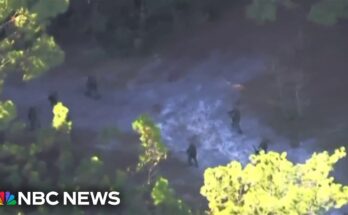In this dramatic footage, law-enforcement officers are hospitalized after violent clashes erupted outside an immigration detention facility operated by U.S. Immigration and Customs Enforcement (ICE). The confrontation took place during a protest in the Chicago suburb of Broadview, Illinois and highlights escalating tensions around immigration enforcement and public demonstration. The Washington Post+2CBS News+2
At approximately 9:30 a.m., a crowd of nearly 300 protesters gathered outside the facility, many singing and praying and holding signs with statements like “God’s Love Knows No Borders” and “God Demands Freedom.” The Washington Post+1 The event, which began as a faith-based vigil, soon turned confrontational when a subset of demonstrators moved past designated barricades and attempted to approach the facility entrance. CBS News+1
According to officials from the Cook County Sheriff’s Office, the clash began when officers attempted to redirect protesters back into the permitted protest area and off the roadway. That’s when things escalated. WTTW News+1 Two officers from the Broadview Police Department and a Cook County deputy were taken to hospital; their injuries were described as non-life-threatening. The Independent+1 An Illinois state trooper was treated on scene. WTTW News+1
By the end of the morning, 21 protesters had been arrested, most on charges of obstruction of roadway, disorderly conduct, and walking on a highway. One individual faced an additional charge of mob action. CBS News+1 The incident raises broader concerns about how incarceration, immigration enforcement and public protest are intersecting in U.S. cities. The facility has been a frequent flashpoint under Operation Midway Blitz, a federal effort that has carried out thousands of arrests in the Chicago area since September. The Washington Post+1

From a viewer’s standpoint, this video offers multiple layers of significance:
- Public protest and civil disobedience: The initial gathering was framed as a vigil led by faith leaders, but quickly transitioned into a conflict zone once demonstrators crossed physical boundaries and confronted law‐enforcement barriers.
- Law-enforcement tactics and risk: Officers were injured while performing crowd management and perimeter control duties. Navigating a protest of this size and intensity near a sensitive federal facility poses significant risk. The hospitalizations underscore that this wasn’t merely a peaceful vigil gone wrong—it required medical treatment for law-enforcement personnel.
- Immigration enforcement backdrop: The ICE facility in Broadview is a key node in regional immigration enforcement, and has drawn repeated protests and controversies. The fact that this facility sits at the intersection of federal enforcement and local activism means clashes like this carry layered meaning: detainee rights, community reaction, and government force.
- Escalation thresholds: What begins as a permitted public demonstration can turn confrontational when lines of demarcation are crossed—barriers, roadways, arrests. The footage likely captures the moment when the allowed protest area was breached, and the law‐enforcement response intensified.
- Broader societal context: The incident invites questions about what tactics protest organizers use, how law enforcement handles high tension situations and whether federal facilities should be shielded differently when large crowds gather. It also touches on the rights of protesters vs. the duties of officers.
In watching this video, you’ll want to pay attention to a few key moments:
- The start of the gathering: how peaceful or organized it appears.
- The moment boundaries are pushed: when protestors leave the designated protest zone or attempt to approach the facility.
- Law-enforcement response: how officers redirect, deploy barriers or make arrests, and then how injuries occur.
- The aftermath: how protesters disperse or are arrested, how officers respond post-incident.
This event is notable not just for the hospitalizations of officers, but for the fact that a protest outside a federal immigration detention facility escalated enough to result in serious law-enforcement injury and multiple arrests. It serves as a microcosm of larger national debates: immigration policy, protest rights, force in public demonstrations, and federal-local relations.
If you’re following similar topics, you may want to consider: How often do officers get hospitalized in protest scenarios outside immigration facilities? What are the protocols for law enforcement in such federal-local settings? How do protest organizers plan around and anticipate law-enforcement responses? How is the public narrative shaped by injuries to officers vs. injuries to protesters?
Here’s the video for you to watch and evaluate:
Watch on YouTube


